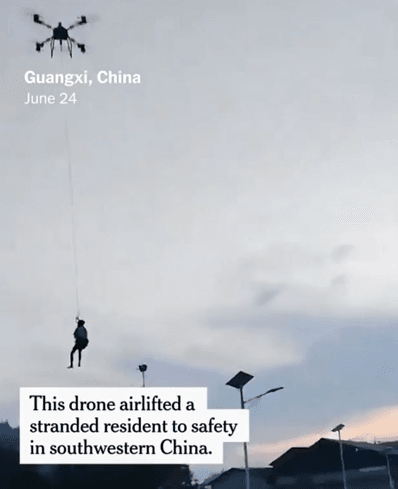You must imagine the fear. Water is rising fast. You are trapped. That was the reality in a recent story from southwestern China. A man was stuck on a small rooftop as floodwaters rushed around him. He had nowhere to go. An agricultural drone appeared.
The operator, Lai Zhongxin, was not on a rescue mission. He was just delivering supplies to other people. But he saw the man. He flew the drone—a machine built for spraying crops—over to the rooftop. He carefully used the drone to lift the man to safety.
The New York Times credited the post, and this started a huge online debate. The main question was simple: Would you trust a drone with your life?
The answers were all over the place. This improvised rescue made people think. We trust helicopters, even though they are very complex machines. We have seen them in movies and news reports for decades. They also have a pilot inside, which feels safe. A drone feels different. It is often flying by itself or with a pilot far away on the ground.
Some people loved the idea of drones. They pointed out that many drones have six or eight rotors. If one motor stops, the others can keep it flying. That is a lot of backup. But other people were very worried. They brought up a big difference. Drones do not have "autorotation." A helicopter pilot can glide the machine down safely if the engine fails. A drone without power? One user said it would "fall like a brick."
This is the core of the trust problem. This whole discussion asks a bigger question about drone reliability in important situations. Mechanical backup systems (like extra rotors) are important. But new sensors like millimeter wave (mmWave) radar are also making drones safer. This technology is quietly changing the game. It helps drones work in bad conditions, like the flood in the story. We must examine what mmWave radar is and why it is a big deal for rescues.
What is Millimeter Wave Radar?
This debate shows we need more than just mechanical backups. We need smarter drones. This is where millimeter wave (mmWave) radar comes in.
This kind of radar operates in a special frequency range, from 30 to 300 GHz. These radio waves are very short (1 to 10 millimeters). This short wavelength is the key. It allows the radar to get a very clear, high-resolution picture of the world. It is not like older, low-resolution radar.
And it is very different from cameras or LiDAR systems. You can think about driving in thick fog or heavy rain. Your eyes (which are like a camera) cannot see. The light from your headlights just bounces off the water droplets. LiDAR (which uses laser light pulses) has the same problem. Its light gets scattered, so it cannot see far.
mmWave signals are different. They are radio waves, not light waves. They go right through the fog, rain, dust, and smoke. This makes the radar the perfect tool for rescue missions. On a rescue, the weather is almost always bad, and visibility is low.
Drones use mmWave radar for a few key jobs. It helps them avoid obstacles. It helps them measure their exact height from the ground. It helps them find and detect objects. It can spot small things, like people or power lines, from far away. It sends this data to the drone's flight computer in real-time. This makes drone navigation and overall safety much better.
How mmWave Radar Helps Drone Rescues
We must think about that Chinese flood rescue again. The drone was made for farm work. It was designed to spray fertilizer and transport materials. Those jobs already need good sensors to fly safely around fields and avoid power lines.
Now, we must put that drone in a flood. The water is rising. Debris is floating everywhere. It is raining hard. A drone with mmWave radar could "see" through all of it. It could find the stranded man much more reliably than a simple camera, which would just see rain on the lens.
This technology has big benefits for rescue work.
A major benefit is its ability to work in any weather. The signals cut through bad conditions and keep working. A rescue mission cannot wait for the weather to clear. Drones need to fly in the middle of the storm, or in the thick smoke of a wildfire, or in dense fog. mmWave radar lets them do that reliably, time after time. This also addresses the "human error" problem. A helicopter pilot in a storm can get disoriented in the fog, but this radar gives the drone's computer perfect vision even when a human pilot could not see.
It also adds a crucial layer of sensing redundancy. The people in the online debate are right. A drone can fail. mmWave adds a new layer of safety that is not mechanical; it is a new set of "eyes." Products like the 60-79GHz mmWave radar give the drone stable information about the world. We can think about an 8-rotor drone. If one motor fails, it can still fly, but it might be unbalanced and weak. It needs to land fast. The mmWave radar can scan the area and find a safe, flat spot to land, even if the pilot (or the drone's camera) cannot see one. It helps the drone manage a failure safely.
The radar is also incredibly precise. In a flood, the water is full of dangerous debris. There are floating logs, parts of houses, and all kinds of trash. A simple camera might see all of this as just "stuff." The mmWave radar is so precise it can be trained to see the difference. It can classify objects. It can find the unique signature of a person and track them, even if they are partially hidden by debris. This is vital. The drone is not just looking for something—it is looking for someone.
After a hurricane, like Katrina, drones with mmWave radar could scan entire neighborhoods. They could check rooftops and trees for survivors, delivering aid or guiding rescue teams much faster than old methods.
Answering the Trust Debate
This brings us back to the trust debate. The online thread focused on physics: Helicopters glide, drones fall. This is true, in a way.
But mmWave radar shifts the whole conversation. It changes the goal from surviving a failure to preventing the failure from ever happening. A helicopter's autorotation is a reaction to a total engine failure. It is a last-ditch effort to land safely. A drone with mmWave radar is designed to never get into that situation in the first place.
It sees a power line in the smoke and stops. It senses the ground getting too close and adjusts. It provides super-accurate altitude data and helps the drone hover perfectly still, even in wind, while it lifts a person. This reduces the risk of a pilot error or sensor error before it becomes a disaster.
When you add this smart sensor to a drone that also has safety parachutes or eight rotors, you get a system that is safe in many different ways. The online commenter said "4 > 1" for rotors. But advanced radar plus multiple rotors is an even better equation. This technology builds a new kind of trust.
The Future of Drone Rescues with mmWave Radar
The Chinese rescue was amazing. But it shows the potential for so much more. That drone was being flown by a skilled human operator. The next step is to make drones even more autonomous.
As the technology gets better, it will be combined with Artificial Intelligence (AI). This is the next big step. The radar provides the "eyes," and the AI provides the "brain."
The AI will process the millions of data points from the radar every second. It will make smart decisions all on its own. For example, a rescue team could tell a drone: "Find all people in this 3-square-mile flood zone." The AI would use the radar to scan the entire area. It would identify human shapes and map their exact locations. It could then plan the safest and fastest flight path between them, avoiding all the new obstacles like fallen trees and debris.
This could make drones just as trusted as helicopters. In some bad-weather situations, where a helicopter cannot fly, they might even be more trusted.
If you work with drones or in emergency services, this is technology to watch. The debate about trust will continue. But one thing is clear: This technology is saving lives and building trust, one safe flight at a time.
What do you think? Would you trust a drone with mmWave radar to save you? Share in the comments!
Frequently Asked Questions (FAQ)
Here are some common questions about this technology.
Q1: What is mmWave radar, and what does it do on a drone? A1: It is a sensor that uses high-frequency signals (30-300 GHz). In drones, its main job is to help the drone understand the world. It helps with avoiding objects, checking the exact height, and finding things. It works very well in bad weather like rain or fog, which cameras and LiDAR cannot.
Q2: Drones can't autorotate. How does radar help with safety? A2: The radar does not give the drone autorotation. That is a mechanical feature. Instead, it helps prevent crashes from happening. It gives the drone very good autonomous obstacle avoidance and helps it hover safely and land safely. It adds a layer of sensing safety to make up for the mechanical risk.
Q3: Why use mmWave radar instead of a camera in a flood? A3: Floods and other disasters usually mean bad weather. There is heavy rain, thick fog, or smoke. Cameras and LiDAR (which use light) stop working in these conditions. The light gets blocked or scattered. mmWave radar signals are radio waves, and they pass right through. This lets the drone keep flying safely and find people when a camera would be blind.
Q4: What is the future of mmWave radar in drones? A4: The next big step is mixing mmWave radar with AI (Artificial Intelligence). The AI will use the radar's clear data to do more than just see. It will be able to find and track objects (like telling a person from a floating log). This will help the drone make smart decisions all by itself and make rescue missions safer and faster.



